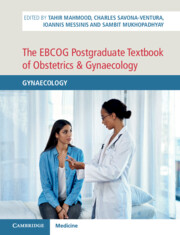Book contents
- The EBCOG Postgraduate Textbook of Obstetrics & Gynaecology
- The EBCOG Postgraduate Textbook of Obstetrics & Gynaecology
- Copyright page
- Dedication
- Contents
- Videos
- Contributors
- Preface
- Section 1 Basic Sciences in Gynaecology
- Section 2 Menstrual Disorders
- Section 3 Reproductive Endocrinology and Infertility
- Chapter 11 Primary and Secondary Amenorrhoea
- Chapter 12 Recurrent Pregnancy Loss in the First and Second Trimesters
- Chapter 13 Polycystic Ovary Syndrome
- Chapter 14 Hirsutism and Virilism
- Chapter 15 Female and Male Infertility
- Chapter 16 Assisted Conception Techniques
- Chapter 17 Ovarian Hyperstimulation Syndrome
- Chapter 18 Legal and Ethical Issues in Assisted Conception Treatment
- Chapter 19 Premature Ovarian Insufficiency
- Section 4 Contraception and STIs
- Section 5 Post-Reproductive Care
- Section 6 Vulva and Vagina
- Section 7 Cervix
- Section 8 Uterus
- Section 9 Ovary and Fallopian Tubes
- Section 10 Operative Gynaecology
- Section 11 Public Health Issues in Gynaecology
- Section 12 Miscellaneous
- Index
- Plate Section (PDF Only)
- References
Chapter 17 - Ovarian Hyperstimulation Syndrome
from Section 3 - Reproductive Endocrinology and Infertility
Published online by Cambridge University Press: 24 November 2021
- The EBCOG Postgraduate Textbook of Obstetrics & Gynaecology
- The EBCOG Postgraduate Textbook of Obstetrics & Gynaecology
- Copyright page
- Dedication
- Contents
- Videos
- Contributors
- Preface
- Section 1 Basic Sciences in Gynaecology
- Section 2 Menstrual Disorders
- Section 3 Reproductive Endocrinology and Infertility
- Chapter 11 Primary and Secondary Amenorrhoea
- Chapter 12 Recurrent Pregnancy Loss in the First and Second Trimesters
- Chapter 13 Polycystic Ovary Syndrome
- Chapter 14 Hirsutism and Virilism
- Chapter 15 Female and Male Infertility
- Chapter 16 Assisted Conception Techniques
- Chapter 17 Ovarian Hyperstimulation Syndrome
- Chapter 18 Legal and Ethical Issues in Assisted Conception Treatment
- Chapter 19 Premature Ovarian Insufficiency
- Section 4 Contraception and STIs
- Section 5 Post-Reproductive Care
- Section 6 Vulva and Vagina
- Section 7 Cervix
- Section 8 Uterus
- Section 9 Ovary and Fallopian Tubes
- Section 10 Operative Gynaecology
- Section 11 Public Health Issues in Gynaecology
- Section 12 Miscellaneous
- Index
- Plate Section (PDF Only)
- References
Summary
Ovarian hyperstimulation syndrome (OHSS) mostly occurs due to excessive FSH stimulation, with final follicle maturation by hCG for IVF. Symptoms usually start 2–4 days after oocyte retrieval; alternatively, endogenous hCG from an implanting embryo can initiate OHSS some days later. Luteinized follicles synthesize vascular endothelial growth factor (VEGF) which induces angiogenesis and increased capillary permeability by inhibition of the cell adhesion molecule vascular endothelial-cadherin (VE-cadherin). This causes fluid leakage from the vascular bed to the third space, resulting in enlarged lutein cysts and ascites. Initial symptoms are bloated abdomen with pain, and in more severe cases dyspnoea, decreased renal and hepatic function and thromboembolism. There is no causal treatment of established OHSS, but there are several prophylactic strategies based on risk evaluation of each patient. In established OHSS, treatment is mainly supportive, by correcting fluid, salt and protein deficits, and low molecular weight heparin for thrombosis prophylaxis.
Keywords
- Type
- Chapter
- Information
- The EBCOG Postgraduate Textbook of Obstetrics & GynaecologyGynaecology, pp. 139 - 145Publisher: Cambridge University PressPrint publication year: 2021

